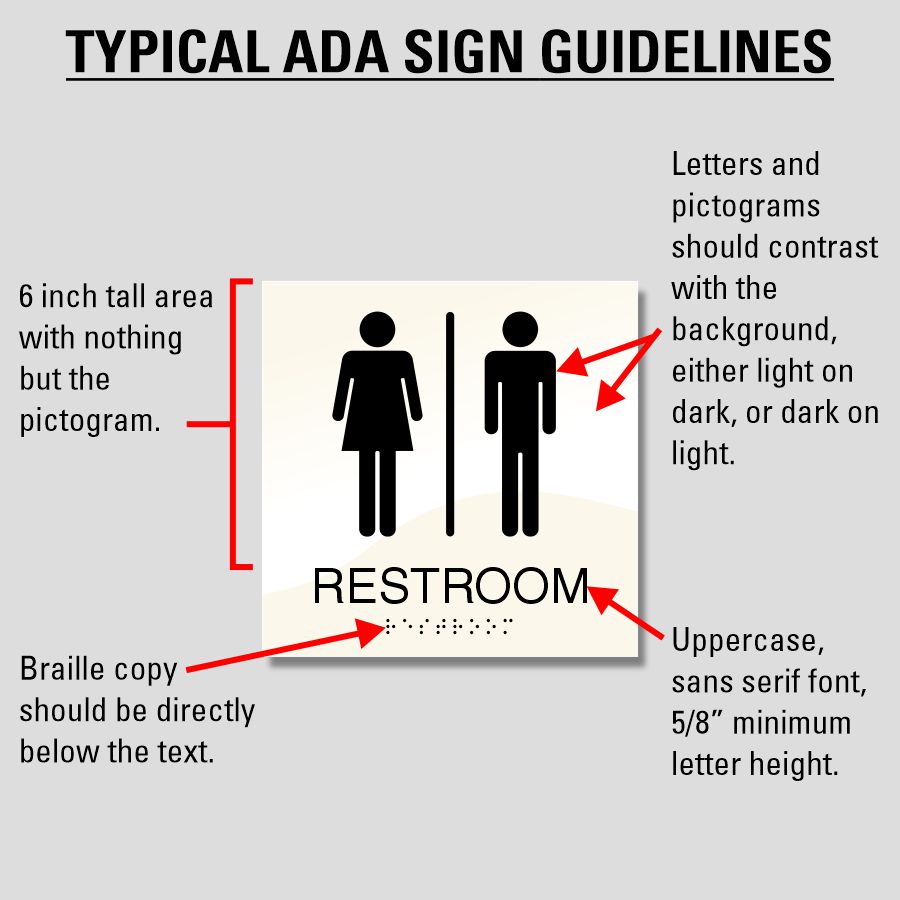ADA Signage: Guaranteeing Accessibility and Conformity in Public Spaces
ADA signs plays an indispensable function in guaranteeing availability and compliance within public areas, significantly adding to a comprehensive atmosphere for individuals with impairments. By sticking to ADA criteria, signage not only helps with navigation but additionally highlights an organization's commitment to diversity and equal rights. As we explore the subtleties of ADA signage, from responsive features to design intricacies, it's vital to take into consideration just how these elements integrate to copyright the civil liberties of all users. What are the typical risks organizations face in preserving compliance, and exactly how can future fads in signage continue to drive availability onward?
Relevance of ADA Signage
In modern culture, the significance of ADA signs expands beyond plain conformity with legal requireds to personify a dedication to inclusivity and ease of access for all individuals. These indicators are necessary in producing settings where individuals with disabilities can browse public spaces with the very same simplicity and freedom as those without handicaps. By offering standardized and clear information, ADA signs makes certain that every person can access centers, services, and information without obstacles.
The significance of ADA signage hinges on its capability to enhance the high quality of life for people with disabilities by promoting equivalent access. It eliminates the obstacles that may otherwise hinder their ability to get involved totally in community life. Furthermore, these indicators serve as noticeable indications of a company's devotion to diversity and equal rights, showing more comprehensive social values that champion the rights and dignity of all individuals.
In addition, ADA signs plays a crucial function in public security. By directing individuals to exits, washrooms, and various other necessary centers, it guarantees that all individuals, no matter physical ability, can evacuate safely throughout emergency situations. In summary, ADA signage is not just a regulatory demand but an effective device for cultivating a equitable and inclusive culture.
Crucial Element of Conformity

Placement is crucial; signs need to be mounted in areas that are conveniently visible and reachable. Normally, signs should be mounted between 48 and 60 inches from the ground to guarantee accessibility for both standing and mobility device users. Tactile components, such as Braille, are necessary for individuals with visual disabilities, providing critical details in a non-visual layout.
High-contrast shades in between the message and background are essential to enhance readability for people with reduced vision. The ADA mandates certain contrast ratios to make certain clearness. Additionally, character size is a key consideration, with minimum height demands dictated by the watching range to guarantee readability from various angles.
Design Considerations for Availability
Designing obtainable signs calls for a meticulous technique to guarantee it meets the requirements of all users, especially those with handicaps. The size of the text is equally critical, with ADA standards advising a minimal elevation based on checking out range to make sure clarity.
Contrasting shades in between message and history are crucial for visibility, specifically for people with aesthetic disabilities. In addition, responsive aspects, such as Braille and raised personalities, are crucial for people who are blind or have low vision.
Additionally, the placement of signage plays a significant duty in access. Indications must be mounted in places that are unblocked and conveniently reachable. Guaranteeing that signs is installed at ideal elevations and angles makes it possible for all users, consisting of those using mobility devices, to communicate with them successfully.
Usual Errors to Stay Clear Of

One more widespread error is the incorrect placement of signs. ADA guidelines define accurate elevation and place requirements to make certain that indicators are easily visible and obtainable by all individuals, including those utilizing wheelchairs. Ignoring these standards not only hampers access but additionally risks non-compliance with lawful standards.
Additionally, inadequate contrast between message and background is a regular oversight. Adequate comparison is essential for readability, especially for people with reduced vision. Developers in some cases continue reading this pick colors that are visually appealing however lack the needed comparison, making the text challenging to recognize.
Finally, some designers fall short to incorporate tactile elements, such as Braille, which are vital for people who are blind. Leaving out these features not just leads to non-compliance with ADA regulations yet also limits accessibility for a segment of the populace that counts on tactile info.
Future Trends in Signage
Improvements in modern technology and enhancing recognition of inclusivity are shaping the future trends in signs layout. As society comes to be extra mindful of varied needs, the assimilation of clever technologies right into signage is obtaining grip. Digital signage, for instance, is developing to include real-time updates and interactive attributes, which can be important in supplying vibrant information in public rooms. These indications often include touch displays or gesture-based controls, making it possible for customers to navigate material tailored to their specific requirements.
An additional arising find out here pattern is the utilization of increased fact (AR) to boost customer experience. AR-enabled signage can overlay electronic information onto the physical setting, offering visually damaged people with auditory or haptic feedback. ADA Signs. This innovation not just improves accessibility but also creates an appealing experience for all individuals
Sustainability is also a considerable variable influencing signs patterns. Environmentally friendly products and energy-efficient illumination remedies are being focused on to align with worldwide environmental goals. Developments in materials science are leading to the advancement of more weather-resistant and durable indicators.
Final Thought
ADA signs plays an essential function in guaranteeing access and compliance within public rooms by incorporating tactile aspects, high-contrast colors, and tactical positioning. The adherence to ADA standards not just promotes risk-free navigation for people with handicaps but additionally signifies a company's devotion to variety and inclusivity. By preventing usual errors and welcoming future patterns, public areas can proceed to advance these values, ensuring that the legal rights and self-respect of all individuals are appreciated and supported.
ADA signage plays an essential function in guaranteeing access and compliance within public areas, significantly adding to an inclusive setting for individuals with disabilities. As we discover the subtleties of ADA signage, from tactile attributes to create intricacies, it's Home Page critical to consider how these components coalesce to maintain the civil liberties of all individuals.In modern-day society, the importance of ADA signs extends past mere conformity with lawful mandates to personify a commitment to inclusivity and access for all people. By offering standardized and clear details, ADA signage makes sure that everyone can access facilities, solutions, and information without barriers.
ADA signs plays an essential role in assuring accessibility and compliance within public spaces by integrating responsive aspects, high-contrast colors, and tactical positioning. (ADA Signs)